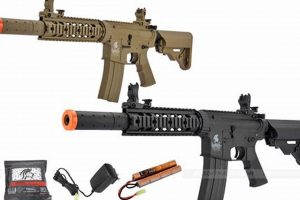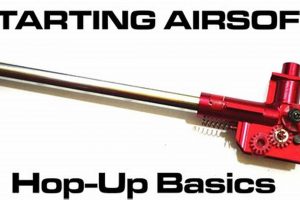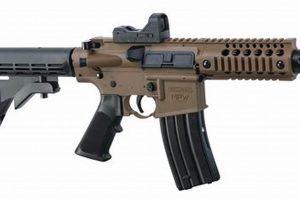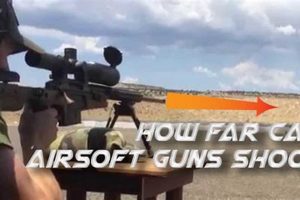The capability of an airsoft gun to inflict lethal harm on a squirrel is a complex issue with ethical, legal, and practical dimensions. Airsoft guns, while designed to fire plastic pellets, possess the potential to cause injury depending on factors such as the gun’s power, the distance to the target, and the point of impact. A direct hit to a vital organ or the head could conceivably result in the death of a small animal like a squirrel.
Understanding the implications of using airsoft guns in this manner is crucial. Many jurisdictions have laws regulating the use of airguns and the harming of wildlife. Even in the absence of specific laws, ethical considerations dictate responsible interaction with animals and the environment. Historically, the use of projectile weapons against wildlife has been governed by principles of conservation and humane treatment. The potential for animal cruelty and the violation of wildlife protection laws are significant concerns.
Therefore, a detailed examination of the factors influencing the lethality of airsoft guns, the legal ramifications of harming wildlife, and the ethical considerations surrounding the issue is warranted. Subsequent discussion will focus on the velocity and pellet weight of airsoft guns, the vulnerability of squirrels, and the legal and ethical frameworks relevant to this issue.
Considerations Regarding the Lethality of Airsoft Guns Against Squirrels
The following points should be considered when assessing the capacity of airsoft guns to cause lethal harm to squirrels. These points address power, range, pellet type, ethical implications, and legal consequences.
Tip 1: Evaluate Airsoft Gun Velocity. Higher velocity airsoft guns, typically exceeding 400 feet per second, pose a greater risk of causing significant injury due to increased impact force. This is a crucial factor in determining potential lethality.
Tip 2: Account for Distance and Trajectory. The effective range of an airsoft gun diminishes with distance, impacting pellet velocity and accuracy. At longer ranges, the pellet’s force is reduced, decreasing the likelihood of a fatal wound. Conversely, closer ranges increase risk.
Tip 3: Recognize Pellet Weight and Material. Heavier pellets transfer more energy upon impact, increasing the potential for tissue damage. Similarly, variations in pellet material influence penetration and overall impact. Standard plastic pellets are less likely to cause lethal injuries than heavier, potentially metal-containing, alternatives.
Tip 4: Understand Vulnerable Areas. A direct hit to the head or vital organs (heart, lungs) significantly increases the risk of severe injury or death. The smaller size of a squirrel makes it particularly vulnerable to such impacts.
Tip 5: Research Legal Restrictions. Local and national laws often regulate the use of airguns and the killing of wildlife. Familiarize oneself with relevant statutes to avoid legal repercussions, which can include fines and confiscation of equipment.
Tip 6: Reflect on Ethical Implications. Employing airsoft guns against animals raises ethical concerns regarding animal cruelty and responsible interaction with wildlife. Consider humane alternatives to deterring squirrels from unwanted areas.
Tip 7: Recognize the Potential for Unnecessary Suffering. Even if an airsoft pellet does not cause immediate death, it can inflict pain, stress, and potentially debilitating injuries. This could lead to a slow and agonizing death for the animal.
Understanding these factors is crucial for making informed decisions regarding the use of airsoft guns and minimizing potential harm to wildlife. Irresponsible use can lead to both ethical and legal ramifications.
In conclusion, a comprehensive understanding of these parameters is necessary to appreciate the potential consequences associated with using airsoft guns in scenarios involving wildlife. The subsequent sections will further elaborate on the legal and ethical landscape surrounding this issue.
1. Velocity
Velocity is a primary determinant in assessing the potential of an airsoft gun to inflict lethal trauma on a squirrel. The kinetic energy transferred upon impact is directly proportional to the square of the velocity; thus, even small increases in pellet speed significantly elevate the risk of severe injury or death. A pellet traveling at a higher velocity penetrates deeper into tissue, increasing the likelihood of damaging vital organs.
For example, an airsoft gun firing a 0.20-gram pellet at 300 feet per second (FPS) generates a specific amount of kinetic energy. If the velocity is increased to 400 FPS, the kinetic energy, and consequently the potential for damage, increases substantially. This escalation in energy can transform a non-lethal impact into one capable of causing internal bleeding, bone fractures, or fatal organ damage in a small animal such as a squirrel. A velocity of around 350 FPS is commonly cited as the threshold above which significant risk to small animals increases, although this is not a definitive line, as other factors are involved. Lower velocity may cause only bruising, while higher speed may cause immediate death.
Understanding the relationship between velocity and potential harm is crucial for responsible airsoft gun usage. The correlation demonstrates that even within the spectrum of airsoft gun capabilities, variations in velocity can drastically alter the outcome of an impact on a small animal. Given the ethical and legal ramifications, knowledge of this factor is essential for preventing unintended harm and ensuring responsible conduct. Control over the velocity of the gun is then, a critical point to determine the danger of it to a squirrel.
2. Pellet Weight
Pellet weight is a significant factor influencing the potential of an airsoft gun to inflict lethal harm on a squirrel. While velocity dictates the initial force, the pellet’s mass determines how much of that force is transferred upon impact. Heavier pellets retain more kinetic energy over a given distance, leading to greater penetration and tissue damage compared to lighter pellets at the same velocity. The relationship between pellet weight and potential for lethality is directly proportional; an increase in mass, while holding velocity constant, escalates the risk of serious injury or death.
Consider two scenarios: an airsoft gun firing a 0.12-gram pellet versus one firing a 0.25-gram pellet, both at 350 FPS. The heavier 0.25-gram pellet carries significantly more kinetic energy, resulting in a greater capacity to penetrate tissue and damage vital organs. For a squirrel, this difference can be the deciding factor between a superficial wound and a fatal injury. A real-world implication lies in the selection of ammunition. Using heavier pellets, often marketed for improved accuracy and range, inadvertently increases the potential for causing lethal harm to unintended targets, including small animals like squirrels. Therefore, the seemingly minor choice of pellet weight becomes a critical variable in determining the outcome of an encounter. The mass helps retain energy on the travel towards the target.
In summary, the understanding of pellet weight’s role is paramount for assessing the risks associated with airsoft gun usage around wildlife. Heavier pellets amplify the potential for lethal impacts, even at moderate velocities. Consequently, responsible use necessitates careful consideration of pellet weight, adherence to ethical principles, and compliance with relevant legal regulations to minimize the risk of unintended harm. It also helps on the overall trajectory of the pellet fired.
3. Impact Location
Impact location is a critical determinant in assessing the potential of an airsoft gun to inflict lethal trauma on a squirrel. The vulnerability of specific anatomical regions directly influences the severity of injury, and therefore, the likelihood of mortality. A pellet striking a non-vital area may cause minimal harm, while impact to a critical area can result in immediate or subsequent death.
- Head and Brain
A direct impact to the head carries a high risk of causing severe neurological damage. The skull, while providing some protection, is relatively thin in squirrels, rendering the brain susceptible to concussive forces and penetration. Damage to the brainstem, cerebellum, or cerebrum can result in immediate death or permanent neurological impairment affecting essential functions such as breathing, motor control, and cognitive abilities.
- Torso and Vital Organs
The torso houses several vital organs, including the heart, lungs, liver, and kidneys. Penetration of the chest cavity can cause pneumothorax (collapsed lung), hemothorax (blood in the chest cavity), or direct trauma to the heart, resulting in rapid circulatory failure. Similarly, damage to the liver or kidneys can lead to internal bleeding and organ dysfunction, potentially causing death over time. The proximity of these organs makes the torso a highly vulnerable area.
- Eyes
Impact to the eyes can cause severe trauma, including corneal abrasions, retinal detachment, and globe rupture. While not immediately fatal, eye injuries can severely impair a squirrel’s ability to navigate its environment, find food, and evade predators. This diminished capacity for survival ultimately reduces its long-term viability, effectively rendering the injury life-threatening.
- Spine
The spinal cord transmits neural signals between the brain and the body. Damage to the spine can cause paralysis, impairing the squirrel’s ability to move and forage. Spinal injuries can range from minor bruising to complete transection of the spinal cord, resulting in permanent loss of motor function below the injury site. The inability to escape predators or find food due to paralysis significantly increases the risk of death.
In summary, impact location is a paramount consideration when assessing the potential lethality of airsoft guns against squirrels. The degree of vulnerability varies significantly across different anatomical regions, with the head, torso, eyes, and spine representing areas where impacts are more likely to result in severe injury or death. The consequences of an impact, therefore, are highly dependent on the precise location of the strike, underscoring the importance of responsible gun handling and awareness of the potential harm inflicted.
4. Squirrel Vulnerability
Squirrel vulnerability is a central factor in determining the potential for an airsoft gun to cause lethal injury. Their small size, relatively thin bone structure, and vital organ placement render them susceptible to trauma from projectiles that might only cause superficial harm to larger animals. The cause-and-effect relationship is direct: increased squirrel vulnerability amplifies the likelihood of severe injury or death from an airsoft pellet impact. A pellet that might only bruise a human or larger animal can penetrate a squirrel’s body cavity, damaging internal organs, bones, or nervous tissue.
The importance of understanding squirrel vulnerability lies in its ethical and practical implications. Ethical considerations demand a heightened awareness of the potential harm inflicted when using airsoft guns in areas inhabited by squirrels. Practically, this understanding informs decisions about where and how airsoft guns are used, what safety precautions are necessary, and whether alternative methods for managing squirrel presence are more appropriate. For instance, an airsoft gun used for target practice in a backyard frequented by squirrels poses a significant risk, particularly given the likelihood of unintended hits to vulnerable areas like the head or torso. Furthermore, squirrels that are already injured or weakened are even more vulnerable, and using airsoft guns around such individuals elevates the risk of mortality.
Ultimately, recognizing squirrel vulnerability underscores the responsibility associated with airsoft gun use. It highlights the need for careful consideration of the potential consequences and the importance of prioritizing humane and ethical practices. Ignoring this vulnerability increases the risk of inflicting unnecessary suffering and violating wildlife protection laws. Education about squirrel anatomy, behavior, and potential injuries can help individuals make more informed decisions and prevent unintended harm. Awareness of their vulnerability can contribute to more informed decision making regarding pest control. The combination of the gun with the animal vulnerability is a key determinant of mortality.
5. Legal Ramifications
The act of killing a squirrel with an airsoft gun is subject to various legal ramifications, depending on jurisdiction. The connection between the act and the legal consequences stems from wildlife protection laws, animal cruelty statutes, and regulations governing the use of airguns. A cause-and-effect relationship exists: the action of killing or injuring a squirrel triggers the application of relevant laws, potentially leading to fines, imprisonment, or confiscation of the airsoft gun. The importance of understanding these legal ramifications is paramount, as ignorance of the law is not a valid defense. The legal consequences serve as a deterrent, aiming to protect wildlife and prevent inhumane treatment of animals. For instance, in many states, squirrels are classified as protected non-game animals, and their killing is prohibited without a specific permit. Violators face penalties ranging from monetary fines to misdemeanor charges, as exemplified by cases where individuals have been prosecuted for unlawfully killing squirrels with air rifles or similar devices.
Furthermore, regulations regarding the use of airguns themselves contribute to the legal landscape. Many municipalities have ordinances that restrict or prohibit the discharge of airguns within city limits or residential areas. Discharging an airsoft gun in violation of these ordinances, even without the intention of harming wildlife, can result in legal penalties. The interaction of these laws creates a complex web of regulations. For example, an individual who discharges an airsoft gun within city limits, resulting in the death of a squirrel, could face charges related to both the unlawful discharge of a weapon and the illegal killing of wildlife. The enforcement of these laws varies depending on location and the severity of the offense, but the potential for legal repercussions is a significant consideration. State wildlife agencies and local law enforcement are typically responsible for enforcing these regulations.
In conclusion, the legal ramifications associated with killing a squirrel with an airsoft gun are multifaceted and underscore the importance of responsible and informed behavior. A lack of awareness of wildlife protection laws, animal cruelty statutes, and airgun regulations can lead to severe legal consequences. The potential penalties serve as a critical deterrent and emphasize the need for individuals to understand and comply with all applicable laws before using airsoft guns, particularly in areas inhabited by wildlife. Adherence to these laws is essential for preventing harm to animals and avoiding legal repercussions, which can range from fines to criminal charges. These laws also underscore a fundamental responsibility to respect wildlife and the environment.
6. Ethical Considerations
The question of whether an airsoft gun can be used to kill a squirrel is inextricably linked to ethical considerations. The potential to inflict harm or death on an animal raises fundamental questions about human responsibility towards wildlife. A direct cause-and-effect relationship exists: the decision to discharge an airsoft gun at a squirrel has the potential consequence of causing suffering or death, regardless of intent. The importance of ethical considerations in this context cannot be overstated. Ethical frameworks provide guidance on how humans should interact with animals, emphasizing the need to minimize harm and respect the intrinsic value of life. For example, utilitiarian ethics would weigh the potential benefit of killing a squirrel (e.g., preventing property damage) against the pain and suffering inflicted on the animal. Deontological ethics, on the other hand, would argue that killing a squirrel is inherently wrong, regardless of the consequences.
Practical applications of these ethical considerations involve evaluating alternative methods of managing squirrel populations that do not involve lethal force. Humane trapping and relocation, habitat modification to deter squirrels, and the use of repellents are examples of non-lethal approaches that align with ethical principles of minimizing harm. These alternatives acknowledge the value of squirrel life and seek to resolve conflicts between humans and wildlife in a responsible manner. Furthermore, understanding the ethical dimensions of the issue promotes a more compassionate and respectful approach to wildlife management, fostering a culture of coexistence rather than domination. This understanding also encourages education and awareness about the ecological role of squirrels and the potential consequences of disrupting natural ecosystems. It promotes public education for the respect of wildlife.
In conclusion, ethical considerations are a crucial component when assessing the use of airsoft guns against squirrels. These considerations highlight the responsibility of humans to minimize harm to wildlife and to explore non-lethal alternatives for managing conflicts. The challenge lies in balancing human needs with the well-being of animals and upholding ethical principles that promote respect for all life. Ethical awareness dictates that lethal force should be considered only as a last resort, after all other reasonable options have been exhausted, and that any action taken should be conducted humanely and in accordance with relevant laws and regulations. All of that while considering the animal is also a living creature.
7. Range Effect
The range at which an airsoft gun is discharged significantly impacts the potential for causing lethal harm to a squirrel. The distance between the weapon and the target directly influences the pellet’s velocity and accuracy, both of which are critical factors in determining the severity of any resulting injury. Consequently, the “range effect” is a crucial element when assessing the possibility of mortality in such scenarios.
- Velocity Degradation
As an airsoft pellet travels, air resistance causes a reduction in its velocity. This deceleration diminishes the kinetic energy upon impact. At longer ranges, the pellet may possess insufficient energy to penetrate the squirrel’s fur and skin, resulting in a negligible injury. Conversely, at close range, the pellet retains a higher velocity, increasing the potential for deep tissue penetration and damage to vital organs. The relationship is inverse; greater range correlates with reduced impact force.
- Accuracy Diminishment
Airsoft guns are inherently less accurate than firearms, and this accuracy further degrades with increased range. Factors such as wind, pellet trajectory, and the shooter’s skill contribute to this decline. A squirrel, being a small and mobile target, becomes increasingly difficult to hit accurately at longer distances. Consequently, even if the pellet retains sufficient velocity, the likelihood of a direct hit to a vulnerable area is reduced. This is an important factor. The longer range increases the chances of missing the target entirely.
- Pellet Trajectory
Airsoft pellets follow a curved trajectory due to gravity. This trajectory becomes more pronounced at longer ranges, requiring the shooter to compensate by aiming higher. However, misjudging the trajectory can result in the pellet striking a different part of the squirrel’s body than intended. This can alter the severity of the injury. A pellet aimed at the head might instead strike the torso, or vice-versa, changing the potential outcome.
- Environmental Factors
External conditions, such as wind and humidity, can significantly influence pellet trajectory and velocity. Wind, in particular, can deflect the pellet off course, making it difficult to achieve accurate shots, especially at longer ranges. High humidity can slightly reduce pellet velocity due to increased air density. These environmental factors contribute to the uncertainty of the impact, further complicating the assessment of potential lethality.
In conclusion, the range at which an airsoft gun is used against a squirrel is a critical factor in determining the potential for mortality. Velocity degradation, accuracy diminishment, pellet trajectory, and environmental factors all contribute to the complexity of the “range effect.” A responsible assessment of this effect is necessary to avoid unintended harm and ensure compliance with legal and ethical standards. The further out, the less likely the squirrel is to be mortally wounded.
Frequently Asked Questions Regarding the Lethality of Airsoft Guns on Squirrels
The following questions and answers address common inquiries and concerns regarding the potential of airsoft guns to cause mortality in squirrels. The information presented is intended to provide a comprehensive understanding of the issue.
Question 1: What is the typical range at which an airsoft gun can inflict a lethal wound on a squirrel?
Lethality depends on multiple factors, including the airsoft gun’s power, the pellet’s weight, and the location of impact. However, close ranges (under 20 feet) present a higher risk due to the pellet’s retained velocity and accuracy. Beyond this range, the probability of a lethal impact decreases.
Question 2: Are there specific types of airsoft guns that pose a greater threat to squirrels?
High-powered airsoft guns with velocities exceeding 400 feet per second (FPS) and the capacity to fire heavier pellets (0.25 grams or more) pose a significantly greater threat due to the increased kinetic energy transferred upon impact.
Question 3: What are the legal consequences of killing a squirrel with an airsoft gun?
The legal consequences vary by jurisdiction. Many regions have wildlife protection laws that prohibit the killing of squirrels without a permit. Violations can result in fines, imprisonment, and confiscation of the airsoft gun.
Question 4: What are the ethical considerations regarding the use of airsoft guns against squirrels?
Ethical considerations involve the humane treatment of animals and the minimization of suffering. Using an airsoft gun against a squirrel raises concerns about animal cruelty, unnecessary harm, and the potential for a prolonged and agonizing death.
Question 5: Are there non-lethal methods for deterring squirrels from unwanted areas?
Yes, several non-lethal methods can be employed, including humane trapping and relocation, habitat modification to deter squirrels, the use of repellents, and exclusion techniques such as fencing or netting.
Question 6: How does the pellet’s impact location affect the likelihood of a lethal outcome?
Impact location is critical. A direct hit to the head, torso (targeting vital organs), or spine significantly increases the risk of severe injury or death. Impacts to non-vital areas may cause pain but are less likely to be fatal.
In summary, the use of airsoft guns against squirrels involves a complex interplay of practical, legal, and ethical considerations. Understanding these factors is essential for responsible decision-making and the prevention of unnecessary harm to wildlife.
Subsequent discussions will explore alternative methods of squirrel control and strategies for coexisting peacefully with wildlife.
Conclusion
The preceding analysis clarifies the potential for an airsoft gun to inflict lethal trauma upon a squirrel. While variables such as pellet velocity, weight, impact location, and range all contribute, the inherent vulnerability of the animal, coupled with legal and ethical constraints, presents a complex scenario. The exploration underscores that the act of using an airsoft gun against a squirrel should not be approached lightly, given the possibility of causing significant harm or death.
The issue extends beyond the technical capabilities of the weapon to encompass broader ethical responsibilities and legal obligations regarding wildlife. The discussion emphasizes the importance of humane practices, legal compliance, and informed decision-making when considering interactions with wildlife. Responsible stewardship of the environment requires that non-lethal alternatives be prioritized and that the potential consequences of any action are carefully evaluated. The discussion emphasizes responsible conduct toward wildlife and adhering to legal guidelines is paramount.







